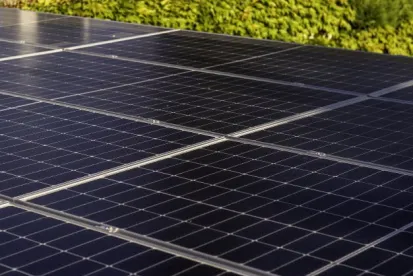On July 27, 2022, Senator Joe Manchin (D-WV) and Senate Majority Leader Chuck Schumer (D-NY) announced that they had reached an agreement on a proposed reconciliation package: the Inflation Reduction Act of 2022, HR 5376, 117th Cong. (Act). The Act includes $369 billion in energy and climate spending and contains several new or expanded sources of government support for the development of a domestic clean energy industry and for the gradual transition to a more sustainable energy economy.
Major provisions of the Act that are of most interest to the clean energy industry include (1) extension and expansion of existing investment and production tax credits for renewable energy; (2) a mechanism to sell tax credits for renewable energy; (3) tax credits for the domestic production of solar cells; (4) manufacturing tax credits for energy storage systems; (5) investment tax credits for industrial or manufacturing facilities for the production of green energy merchandise; (6) additional funding for US Department of Energy (DOE) loans; (7) a 10-year extension of tax credits for rooftop solar panels; and (8) a program for energy-efficient affordable housing.
Importantly, the Act contains an additional $500 million appropriation to carry out the Defense Production Act (DPA). The Act does not contain, nor have we seen elsewhere, any additional information on the specifics of how the Biden administration intends to use these appropriated funds. The administration has previously announced its intention to use the DPA to accelerate the domestic production of solar cells and related materials.
IN DEPTH
A DEEPER DIVE
Getting a bit more granular on each of the above:
1. Renewable Energy Tax Credits: The Act incorporates many of the original features we saw in last year’s Build Back Better Act proposals:
- The production tax credit (PTC) and investment tax credit (ITC) would both be extended without phasedown for projects placed in service in 2022 or later (e., 30% ITC and 100% PTC). The existing credits would disappear for projects beginning construction before 2025. At that time, they are replaced with a technology-neutral zero carbon emissions production or investment credit, which would look similar to the existing PTC and ITC. The new credits would start to phase out for projects beginning construction in the later of 2034 or once annual greenhouse gas emissions fall by at least 75% from 2022 levels.
- The Act includes the wage and apprentice concepts introduced last year in roughly the same form; that is, for projects larger than one megawatt that begin construction after the issuance of subsequent Internal Revenue Service (IRS) regulations, the base credit drops to 20% its previous value unless certain requirements are met.
- The Act also maintains the 10% domestic content bonus for both the PTC and ITC and a 10% bonus for projects built in certain communities with ties to traditional energy resources.
- The ITC includes a 30% standalone credit for energy storage, subject to all the same requirements as the general ITC (g., wage and apprentice rules). Interconnection property is just as eligible for the ITC.
- The ITC is eligible for an additional 10% – 20% boost for projects in certain low-income communities and buildings. Taxpayers appear to be eligible for all the various bonuses (in other words, ITC projects could be eligible for 50% or more credits).
- The credit for carbon capture would be extended to projects beginning construction before 2033, with substantive modifications to the current rules.
- One feature of the Build Back Better Act that looks significantly different in this Act is the “direct pay” feature. In last year’s proposals, taxpayers could elect to take a cash refund from the IRS for the value of the tax credits, even if the taxpayer didn’t have sufficient tax liability to claim the credit. This was something the industry was really hoping to see in the enacted version. The Act kept the direct pay mechanism but mostly limited it to tax-exempt taxpayers. The exceptions are the credits for carbon sequestration, clean hydrogen and advanced manufacturing of certain renewable components (discussed below), for which direct pay would still be available to taxable taxpayers.
- While the exclusion of direct pay may be a disappointment for some, taxpayers were in for a surprising, happy alternative: The Act includes a credit transfer provision, whereby taxpayers can sell all or part of their tax credits to unrelated persons. The sale must be for cash, and there are penalties if the claimed credit amount is excessive. This mechanism is likely to be a game changer in the industry and may, in some cases, eliminate the need for complicated tax equity structures.
- The Act also permits tax credit carrybacks of three years and carryforwards of 22 years.
2. Tax Credits for the Domestic Production of Solar Cells, Modules and Components: The Act includes most of the operative provisions of the proposed Solar Energy Manufacturing for America Act, in particular, tax credits for the domestic production of solar cells, modules and components thereof. The specific credits are:
- 11 cents/watt for integrated modules
- 7 c/w for non-integrated solar modules
- 4 c/w for cells
- $12/m.2 of wafer
- $3/kg of polysilicon
- 40 c/m.2 of polymeric backsheet[1]
- Estimated uptake of these credits and other production tax credits in the Act for wind turbines, batteries and critical minerals processing are $30 billion.
3. Manufacturing Tax Credits: The Act would expand advanced manufacturing tax credits to cover up to a 30% credit for energy storage systems.[2]
4. Tax Credits for Industrial or Manufacturing Facilities: The Act has $10 billion in investment tax credits for industrial or manufacturing facilities to produce green-energy merchandise, including solar cells and related components, wind turbine components, electric and hybrid vehicles and renewable fuel production equipment.[3]
5. DOE Loans: The DOE will receive an additional $40 billion for loans under section 1703 of the Energy Policy Act of 2005 and $5 billion for activities under section 1706 of that act.[4]
6. Residential: Several other provisions of the Act should also increase domestic demand for solar panels and related equipment, including:
- A 10-year extension of tax credits for rooftop solar panels (along with other consumer energy merchandise, such as heat pumps and electric HVAC systems and water heaters)[5]
- A $1 billion program for energy-efficient affordable housing.[6]
7. DPA: The Biden administration has previously announced its intention to use the DPA to accelerate the domestic production of solar cells and related materials.[7] The Act contains an additional $500 million appropriation to carry out the DPA.[8] However, the Act does not specify (nor has other information been released about) how the administration intends to use these appropriated funds.
We’ve noted that the Act has not yet received the public support of all other Democratic senators, nor has it passed the Senate Parliamentarian’s review for reconciliation purposes (referred to as a “Byrd Bath”), both of which will be required before the Act can be passed—assuming no Republican senators support the bill. As such, much of the above is subject to amendment and could be removed if found to be outside of the scope of reconciliation by the Senate Parliamentarian.








 />i
/>i

